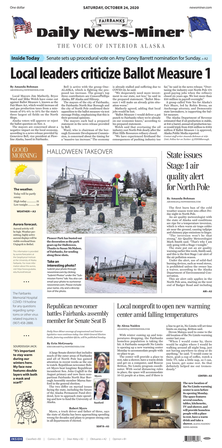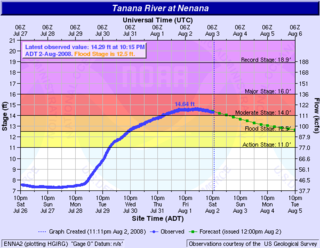
Fairbanks is a home rule city and the borough seat of the Fairbanks North Star Borough in the U.S. state of Alaska. Fairbanks is the largest city in the Interior region of Alaska and the second largest in the state. The 2020 Census put the population of the city proper at 32,515 and the population of the Fairbanks North Star Borough at 95,655, making it the second most populous metropolitan area in Alaska after Anchorage. The Metropolitan Statistical Area encompasses all of the Fairbanks North Star Borough and is the northernmost Metropolitan Statistical Area in the United States, located 196 miles by road south of the Arctic Circle.

The Chena River is a 100-mile (160 km) tributary of the Tanana River in the Interior region of the U.S. state of Alaska. It flows generally west from the White Mountains to the Tanana River near the city of Fairbanks, which is built on both sides of the river. The Tanana empties into the 2,300-mile (3,700 km) long Yukon River.

The Roman Catholic Diocese of Fairbanks is an ecclesiastical territory, or diocese, of the Roman Catholic Church in the northern part of the state of Alaska in the United States. As of 2023, the diocese had 46 parishes and missions, with 14 priests, to serve 11,876 Catholics, in an area of 409,849 square miles (1,061,500 km2), making it geographically the largest diocese in the United States.

The Fairbanks Daily News-Miner is a morning daily newspaper serving the city of Fairbanks, Alaska, the Fairbanks North Star Borough, the Denali Borough, and the Yukon-Koyukuk Census Area in the U.S. state of Alaska. It is the farthest north daily in the United States, and one of the farthest north in the world. The oldest continuously operating daily in Alaska, by circulation it is the second-largest daily in the state. It was purchased by the Helen E. Snedden Foundation in 2016. The Snedden family were longtime owners of the News-Miner, selling it to a family trust for Dean Singleton and Richard Scudder, founders of the Media News Group in 1992.

Chena was a former city in interior Alaska, located in the Fairbanks North Star Borough, Alaska, United States, near the confluence of the Chena and Tanana rivers. It incorporated in 1903 and was disincorporated in 1973. The area is now part of the outskirts of Fairbanks, within the CDP of Chena Ridge. Its heyday was in the first two decades of the 20th century, with a peak population of about 400 in 1907. By 1910 the population had fallen to 138.
Monroe Catholic High School is a private, Roman Catholic high school in Fairbanks, Alaska. It is the only Catholic high school in the Roman Catholic Diocese of Fairbanks. It is the northernmost Roman Catholic high school in the Americas.

Kulis Air National Guard Base was a National Guard of the United States facility in Anchorage, Alaska. The 127-acre (51 ha) facility adjacent to and south of Ted Stevens International Airport was home to the 176th Wing of the Alaska Air National Guard until that unit moved to Joint Base Elmendorf-Richardson in February 2011. The property thereafter reverted to ownership by the State of Alaska, which as of April 2011 had not yet announced plans for the property.

Sacred Heart Cathedral is a cathedral of the Catholic Church in the United States. It is the mother church of the Diocese of Fairbanks and is the seat of the bishop of the diocese. It is located in the City of Fairbanks in the state of Alaska and sits close to the geographic center of the city.

The 2008 Tanana Valley flood or the 2008 Fairbanks flood was a flood in late July and early August 2008 that affected several rivers in the central portion of the American state of Alaska. The city of Fairbanks, Alaska saw high water levels, while the towns of Nenana, Salcha, and Old Minto received heavy damage. The Salcha River and Tanana River reached their second-highest levels since record-keeping began, while the Chena River, which bisects Fairbanks, was kept below flood stage by the use of the Chena River Lakes Flood Control Project.

Felice Pedroni, known best to Americans by his Hispanicized alias Felix Pedro, was an Italian immigrant whose discovery of gold in Interior Alaska marked the beginning of the 1902 Fairbanks Gold Rush.

The Fairbanks Gold Rush was a gold rush that took place in Fairbanks, Alaska in the early 1900s. Fairbanks was a city largely built on gold rush fervor at the turn of the 20th century. Discovery and exploration continue to thrive in and around modern-day Fairbanks.

Elbridge Truman Barnette was a Yukon riverboat captain, banker, and swindler, who founded the city of Fairbanks, Alaska, and later served as its first mayor.

The history of Fairbanks, the second-largest city in Alaska, can be traced to the founding of a trading post by E.T. Barnette on the south bank of the Chena River on August 26, 1901. The area had seen human occupation since at least the last ice age, but a permanent settlement was not established at the site of Fairbanks until the start of the 20th century.

The Masonic Temple was a historic two-story wooden building at 809 1st Avenue, near the Chena River in Fairbanks, Alaska. It was built in 1906, expanded in 1908, and further altered in 1913 and 1916. Its architecture was "eclectic Renaissance Revival", a style that had been popular in the "lower 48" United States in the 1880s and 1890s. It was listed on the National Register of Historic Places in 1980.
The sexual abuse scandal in the Catholic diocese of Fairbanks is a major chapter in the series of Catholic sex abuse cases in the Diocese of Fairbanks in the state of Alaska in the United States and the Jesuits religious order.

The Immaculate Conception Church is a historic church and former cathedral at 115 N. Cushman Street in Fairbanks, Alaska, United States.

Saint Wilfrid's is a Roman Catholic church run by the Society of Jesus, in the city centre of Preston, Lancashire, England. It was built in 1793 and is situated between Fishergate and Winckley Square on Chapel Street.

The St. Peter's Mission Church and Cemetery, also known as St. Peter's Mission and as St. Peter's-By-the-Rock is a historic Roman Catholic mission located on Mission Road 10.5 miles (16.9 km) west-northwest of the town of Cascade, Montana, United States. The historic site consists of a wooden church and "opera house" and a cemetery. Also on the site are the ruins of a stone parochial school for boys, a stone convent, and several outbuildings.

St Joseph's Convent is a complex of 18th- and 19th-century buildings in Taunton, Somerset, which were primarily used as a Roman Catholic convent, first by the Franciscans, and then Sisters of St. Joseph of Annecy. The buildings were sold out of the Catholic church in 1976, and were redeveloped as residential flats in 2005. The main building is designated by English Heritage as a Grade II* listed building, while the boundary walls on the west side are Grade II listed.

Harold B. Foss (1910-1988) was an American architect from Juneau, Alaska.


















